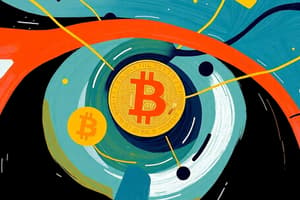Podcast
Questions and Answers
Why does Alice need to create a new output when paying Bob from an existing output worth more than the payment amount?
Why does Alice need to create a new output when paying Bob from an existing output worth more than the payment amount?
- To donate the excess amount to the miner as an additional fee.
- To split the output into smaller denominations acceptable by Bob.
- To return the excess amount back to herself, using a change address. (correct)
- To comply with regulations on transaction outputs.
In Bitcoin transactions, what constitutes the transaction fee, and who receives it?
In Bitcoin transactions, what constitutes the transaction fee, and who receives it?
- A fixed percentage of the total transaction value, paid to the network administrators.
- A mandatory charge based on transaction size, distributed among all nodes.
- A dynamically adjusted fee, based on network congestion, burned to reduce the total supply of Bitcoin.
- The difference between the sum of input values and the sum of output values, awarded to the miner. (correct)
What is the purpose of the lock_time field within the metadata of a Bitcoin transaction?
What is the purpose of the lock_time field within the metadata of a Bitcoin transaction?
- To set a future date or block height before which a transaction cannot be added to a block. (correct)
- To indicate the time when the transaction was initially created.
- To specify the duration a transaction remains valid.
- To immediately lock the transaction, preventing any modifications.
How do Bitcoin scripts enable the specification of conditions for spending coins?
How do Bitcoin scripts enable the specification of conditions for spending coins?
What distinguishes scriptPubKey from scriptSig in Bitcoin scripting?
What distinguishes scriptPubKey from scriptSig in Bitcoin scripting?
How does Bitcoin utilize cryptography in the context of script execution?
How does Bitcoin utilize cryptography in the context of script execution?
Why is Bitcoin's scripting language designed to be non-Turing complete?
Why is Bitcoin's scripting language designed to be non-Turing complete?
What is the purpose of using Pay-to-Script-Hash (P2SH) in Bitcoin transactions?
What is the purpose of using Pay-to-Script-Hash (P2SH) in Bitcoin transactions?
In the context of Bitcoin, what does a 'Green address' signify?
In the context of Bitcoin, what does a 'Green address' signify?
How do escrow transactions function to ensure fair exchange between parties in Bitcoin?
How do escrow transactions function to ensure fair exchange between parties in Bitcoin?
Which element within a Bitcoin block header directly relates to the mining process and difficulty?
Which element within a Bitcoin block header directly relates to the mining process and difficulty?
What type of data is represented by the Merkle Root found in a Bitcoin block header?
What type of data is represented by the Merkle Root found in a Bitcoin block header?
Which of the following best describes the role of a Coinbase transaction in Bitcoin?
Which of the following best describes the role of a Coinbase transaction in Bitcoin?
Why does the Coinbase transaction input contain a null hash pointer?
Why does the Coinbase transaction input contain a null hash pointer?
What is the significance of the output value in a Coinbase transaction?
What is the significance of the output value in a Coinbase transaction?
What is the term used to describe the propagation method by which transactions are shared across the Bitcoin network?
What is the term used to describe the propagation method by which transactions are shared across the Bitcoin network?
What is the potential consequence of network latency regarding the pending transaction pool?
What is the potential consequence of network latency regarding the pending transaction pool?
What causes a 'race condition' within the Bitcoin network?
What causes a 'race condition' within the Bitcoin network?
What is the primary criterion a node uses to forward a newly announced block in the Bitcoin network?
What is the primary criterion a node uses to forward a newly announced block in the Bitcoin network?
What is the approximate number of reachable nodes in the Bitcoin network as of February 2025?
What is the approximate number of reachable nodes in the Bitcoin network as of February 2025?
What is the estimated storage space required to operate a full Bitcoin node as of February 2025?
What is the estimated storage space required to operate a full Bitcoin node as of February 2025?
What is the minimum RAM requirement for running a full Bitcoin node?
What is the minimum RAM requirement for running a full Bitcoin node?
What is the approximate number of Unspent Transaction Outputs (UTXOs) maintained by the Bitcoin network as of February 2025?
What is the approximate number of Unspent Transaction Outputs (UTXOs) maintained by the Bitcoin network as of February 2025?
How does a Simplified Payment Verification (SPV) client, or 'thin node,' differ from a full node in the Bitcoin network?
How does a Simplified Payment Verification (SPV) client, or 'thin node,' differ from a full node in the Bitcoin network?
What is the internet connection requirement to operate a full node?
What is the internet connection requirement to operate a full node?
What is the limitation on the blockchain regarding cryptographic algorithms?
What is the limitation on the blockchain regarding cryptographic algorithms?
Which of the following best describes a hard fork in a blockchain?
Which of the following best describes a hard fork in a blockchain?
What is the key characteristic of a soft fork in the context of blockchain technology?
What is the key characteristic of a soft fork in the context of blockchain technology?
What happens within the Bitcoin network if not all nodes upgrade to the newest version of the software after a hard fork?
What happens within the Bitcoin network if not all nodes upgrade to the newest version of the software after a hard fork?
When does a soft fork become enforceable on the Bitcoin network?
When does a soft fork become enforceable on the Bitcoin network?
What is a primary difference between hard forks and soft forks in terms of their impact on blockchain validation?
What is a primary difference between hard forks and soft forks in terms of their impact on blockchain validation?
According to the provided material, what is the nature of the consensus that Bitcoin miners perform?
According to the provided material, what is the nature of the consensus that Bitcoin miners perform?
What is the main motivation for Bitcoin miners to participate in the consensus protocol and validate transactions?
What is the main motivation for Bitcoin miners to participate in the consensus protocol and validate transactions?
Which of the following statements correctly describes how Bitcoin handles change when a user sends a transaction?
Which of the following statements correctly describes how Bitcoin handles change when a user sends a transaction?
What can speed up transaction verification?
What can speed up transaction verification?
Which of the following best describes the inputs component of a Bitcoin transaction?
Which of the following best describes the inputs component of a Bitcoin transaction?
What does scriptSig contain?
What does scriptSig contain?
According to the provided text, which of the following is correct about the bitcoin script?
According to the provided text, which of the following is correct about the bitcoin script?
According to the provided text, which of the following best describes the purpose of the proof-of-burn concept?
According to the provided text, which of the following best describes the purpose of the proof-of-burn concept?
In the Bitcoin block header, what is the purpose of the mrkl_root field?
In the Bitcoin block header, what is the purpose of the mrkl_root field?
Flashcards
Ledger in Bitcoin
Ledger in Bitcoin
A consensus mechanism that provides an append-only record of transactions.
Miners in Bitcoin
Miners in Bitcoin
Individuals or entities that perform the consensus protocol and validate transactions on the Bitcoin network.
Transaction-based ledger
Transaction-based ledger
A distributed, permissionless record which tracks balances after each transaction.
Bitcoin Inputs
Bitcoin Inputs
Signup and view all the flashcards
Bitcoin outputs
Bitcoin outputs
Signup and view all the flashcards
Change Address
Change Address
Signup and view all the flashcards
Efficient Transaction Verification
Efficient Transaction Verification
Signup and view all the flashcards
Bitcoin Metadata
Bitcoin Metadata
Signup and view all the flashcards
Bitcoin Inputs
Bitcoin Inputs
Signup and view all the flashcards
Bitcoin outputs
Bitcoin outputs
Signup and view all the flashcards
Transaction Fee
Transaction Fee
Signup and view all the flashcards
Bitcoin Scripts
Bitcoin Scripts
Signup and view all the flashcards
scriptPubKey
scriptPubKey
Signup and view all the flashcards
scriptSig
scriptSig
Signup and view all the flashcards
Proof-of-burn
Proof-of-burn
Signup and view all the flashcards
Pay-to-script-hash (P2SH)
Pay-to-script-hash (P2SH)
Signup and view all the flashcards
Escrow Transactions
Escrow Transactions
Signup and view all the flashcards
Block Header
Block Header
Signup and view all the flashcards
mrkl_root
mrkl_root
Signup and view all the flashcards
Coinbase Transaction
Coinbase Transaction
Signup and view all the flashcards
Coinbase Transaction Reward
Coinbase Transaction Reward
Signup and view all the flashcards
Peer-to-peer Bitcoin Network
Peer-to-peer Bitcoin Network
Signup and view all the flashcards
Race Condition
Race Condition
Signup and view all the flashcards
Thin Nodes
Thin Nodes
Signup and view all the flashcards
SPV Clients
SPV Clients
Signup and view all the flashcards
Bitcoin Limitations
Bitcoin Limitations
Signup and view all the flashcards
Hard Fork
Hard Fork
Signup and view all the flashcards
Soft Fork
Soft Fork
Signup and view all the flashcards
Hard Fork
Hard Fork
Signup and view all the flashcards
Soft Fork
Soft Fork
Signup and view all the flashcards
Study Notes
Bitcoin Mechanics
- Bitcoin uses a consensus mechanism that provides an append-only ledger.
- Data, once written, remains permanently.
- Miners execute a consensus protocol to validate transactions.
- Miners are incentivized by a digital currency.
Transaction-Based Ledger
- Each transaction tracks Alice's balance.
- Transactions specify a number of inputs and outputs.
- Inputs represent coins consumed that were created in prior transactions.
- Outputs represent newly created coins.
- When new currency is minted, there are no inputs.
- Each transaction has a unique ID, and outputs have indexes, starting at 0.
Change Addresses
- Transaction outputs must be fully consumed or not at all.
- Alice needs to send money to herself if she does want to consume an entire output.
- For example, Alice can send 17 of 25 bitcoins to Bob and 8 back to herself.
- The address that the 8 bitcoins are sent to must be owned by her, but can be different.
- This type of address is called a change address.
Efficient Transaction Verification
- The transaction output that Alice references is looked up by a hash pointer.
- The transaction output value must be 25 bitcoins.
- It also must not have been spent previously.
- Scan the block chain between the referenced and most recent block.
- Data structures can further improve speed.
Bitcoin Transaction Anatomy
- Each Bitcoin transaction consists of three parts: metadata, inputs, and outputs.
Transaction Metadata
- Includes the transaction size, the number of inputs, outputs, the transaction ID, and "lock_time."
Transaction Inputs
- An array specifying a previous transaction (hash pointer), the index of the previous transaction’s outputs, and a cryptographic signature.
Transaction Outputs
- An array where each output includes a value and a recipient address (script). If output values are less than the sum of input values, the miner keeping the difference as a transaction fee.
Bitcoin Scripts
- Bitcoin scripts specify arbitrary conditions for spending coins.
- An address is essentially a hash of a public key.
- Bitcoin only allows signing of an entire transaction.
- scriptPubKey means something can be redeemed by a public key that hashes to X, along with an owner's signature.
- scriptSig contains scripts instead of signatures.
- The scripting language is stack-based and not Turing-complete because it has no loops.
- It is built with cryptography in mind, with special instructions for hashing and signature verification.
- The combination of a new transaction's input script and the earlier transaction's output script validates transaction output redemption.
Bitcoin Script Applications
- Proof-of-burn bootstraps an alternative Bitcoin or adds arbitrary data to the blockchain.
- Pay-to-script-hash (P2SH) allows complicated conditions for spending coins and MULTISIG addresses.
- Escrow Transactions help mediate payment when Alice doesn’t want to pay until the goods arrive.
- Green addresses help when Bob is a street vendor selling hot dogs, and one would not want Alice to wait an hour for food.
- Micropayments help when Bob is providing Alice with a wireless service and charges her a small fee for every minute she talks on her phone.
Bitcoin Blocks
- It contains information related to the mining puzzle.
- Block headers include a changeable "nonce", a timestamp, and "bits" for difficulty indication.
- The transaction tree root, or "mrkl_root" field, is the only transaction data in the header.
Coinbase Transactions
- This is a transaction that creates new Bitcoins.
- It has only one input and one output.
- The input does not redeem a previous output; its hash pointer is null.
- The value of the output is the miner's revenue, which halves every 210,000 blocks (4 years).
- The output is the mining reward plus transaction fees.
The Bitcoin Network
- Bitcoin operates on a peer-to-peer network over TCP with a random topology.
- New nodes can join anytime; inactive nodes are forgotten after three hours.
- Joining requires contacting any existing node.
- Transactions are broadcast using a simple flooding or gossip protocol.
Race Condition
- Network latency can cause different views of the pending transaction pool among nodes.
- A race condition happens when nodes disagree on transactions for the next block due to double-spending.
- The miner of the next block ultimately resolves the tie.
New Block Propagation
- Announcing new blocks uses similar logic to propagating new transactions.
- Nodes forward blocks only if they extend the longest blockchain branch known to them.
- A 2013 study reported an average block propagation time of around 12.6 seconds.
Network Size
- The Bitcoin network included approximately 16,000 reachable nodes as of February 22, 2025.
- Running a full Bitcoin node as of February 22, 2025, needs 600 GB of storage and 2 GB of RAM.
Full Nodes
- Fully validating nodes must store the entire set of unspent transaction outputs (UTXOs) in RAM.
- The Bitcoin network has processed roughly 1.157 billion transactions since 2009 as of February 21, 2025.
- The Bitcoin network as of February 22, 2025, has approximately 80 million Unspent Transaction Outputs (UTXOs).
- The Bitcoin network handles about 500,000 transactions each day, as of February 22, 2025.
Thin Nodes
- Thin nodes are also named Simple Payment Verification (SPV) clients, and they verify only transactions they care about.
- Block headers take up only about 1/1,000 the size of the block chain.
- Bitcoin had about 840,000 blocks as of February 2025, or ~67 MB.
Node Requirements
- Full Node Requirements:
- 1 TB SSD storage, with the blockchain being ~550 GB as of 2025.
- 4 GB RAM (8 GB+ is recommended).
- Intel i5/i7, AMD Ryzen 5/7 CPU, or equivalent.
- 500 GB/month Internet connection with a minimum of 50 Mbps speed.
- SPV Node Requirements:
- <10 MB storage for block headers.
- 512 MB+ RAM.
- Low-end CPU (e.g., Raspberry Pi, smartphones).
- ~10 MB/month Internet connection for headers.
Limitations
- The Bitcoin protocol has many constraints that are hard-coded, which can affect the system.
- Total number of Bitcoins, mining incentives, and the limits the average time per block are not malleable.
- These limitations are set on the average time per block, signature operations in a block, and the divisibility of the currency.
System Throughput
- Each block is limited to one megabyte.
- Each transaction is at least 250 bytes.
- Each block can handle 4,000 transactions.
- Blocks are found about every 10 minutes, creating about 7 transactions per second.
- Bitcoin's cryptographic algorithms are fixed.
- Software updates don't guarantee universal adoption across all nodes.
Hard Forks
- The new software recognizes blocks as valid; the old software rejects them.
- Most nodes have upgraded, but some have not, so the blockchain splits.
- The longest branch will contain blocks invalid to old nodes.
- The old nodes will work on a block chain branch excluding the new feature.
- The branches will never join, considered unacceptable.
Soft Forks
- Features are added to make validation rules stricter.
- The old version accepts all blocks; the new version rejects some.
- If the majority of nodes switch to the new software, they can enforce the new rules.
- P2SH is an example.
Hard Fork vs. Soft Fork
- A hard fork is a major protocol upgrade and is not backward compatible. This creates a split in the blockchain.
- A soft fork is a minor protocol upgrade and is backward compatible. Old nodes recognize new blocks but may not enforce all the new rules.
Studying That Suits You
Use AI to generate personalized quizzes and flashcards to suit your learning preferences.




